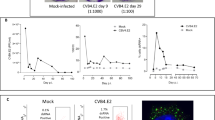Abstract
Encephalomyocarditis virus (EMC) possesses many of the biological and pathogenetic features of the human Group B coxsackieviruses which have been implicated in the aetiology of insulin-dependent diabetes mellitus1,2. The M variant of EMC produces a diabetes-like disease when inoculated into some strains of mice. In these animals, cytolysis of β-cells is prominent, and there is an accompanying mononuclear inflammatory cell response (insulitis). Hyperglycaemia is observed during the acute stages of infection followed by varying degrees of carbohydrate intolerance3–5. In other mouse strains, β-cell lesions are less prominent and insulitis fails to occur, even though the animals develop a systemic infection. In these animals diabetes is observed either infrequently or not at all. Although the susceptibility of mice to the diabetogenic effect of the virus is believed to be influenced by one or more recessive genes, the pathogenetic basis for differences between the strains has not been defined6,7. The basis for the unique tropism of the M variant for β-cells also is uncertain because other serotypically similar strains of this virus cause pancreatic acinar cell necrosis, but lack a diabetogenic effect3,5. We have studied mouse pancreatic β-cells in tissue culture to determine whether or not these cells are uniquely susceptible to the M variant of EMC. Additionally, we examined the viral susceptibility of cultured β-cells derived from mouse strains that varied in their resistance to the diabetogenic effects of the M variant. The results show that cultured mouse β-cells can be infected by a variety of EMC viruses, and β-cells from different strains of mice are susceptible to infection by the M variant of EMC.
This is a preview of subscription content, access via your institution
Access options
Subscribe to this journal
Receive 51 print issues and online access
$199.00 per year
only $3.90 per issue
Buy this article
- Purchase on Springer Link
- Instant access to full article PDF
Prices may be subject to local taxes which are calculated during checkout
Similar content being viewed by others
References
Gamble, D. R., Taylor, K. W. & Cumming, H. Br. med. J. 4, 260–262 (1973).
Yoon, J. W., Austin, M., Onodera, T. & Notkins, A. L. New Engl. J. Med. 300, 1173–1179 (1979).
Craighead, J. E. & McLane, M. F. Science 162, 913–914 (1968).
Craighead, J. E., Kanich, R. E. & Kessler, J. B. Am. J. Path. 74, 287–300 (1974).
Craighead, J. E. New Engl. J. Med. 299, 1439–1445 (1978).
Craighead, J. E. & Higgins, D. A. J. exp. Med. 139, 414–425 (1974).
Boucher, D. W., Hayashi, K., Rosenthal, J. & Notkins, A. L. J. infect. Dis. 131, 463–466 (1975).
Sternberger, L. A., Hardy, P. H., Cuculis, J. J. & Meyer, H. G. J. Histochem. Cytochem. 18, 315–333 (1970).
Wilson, G. L., Chick, W. L. & Appel, M. C. TCA Manual (in the press).
Wilson, G. L. & Craighead, J. E. (in preparation).
Chick, W. L., Lauris, V., Flewelling, J. E., Andrews, K. A. & Woodruff, J. M. Endocrinology 92, 212–218 (1973).
Craighead, J. E. Am. J. Path. 48, 333–345 (1966).
Takemoto, K. K. & Leibhaber, H. Virology 14, 455–562 (1961).
Dick, G. W. A., Smithburn, K. E. & Haddow, A.J. Br. J. exp. Path. 29, 547–588 (1948).
Craighead, J. E. Proc. Soc. exp. Biol. Med. 119, 408–412 (1965).
Macchi, A., Zeytinoglu, F. & Beaser, S. B. Proc. Soc. exp. Biol. Med. 145, 500–503 (1974).
Yoon, J. W. & Notkins, A. L. J. exp. Med. 143, 1170–1185 (1976).
Chairez, K., Yoon, J. W. & Notkins, A. L. Virology 85, 606–611 (1978).
Leiter, E. H., Coleman, D. L. & Eppig, J. J. In Vitro 15, 507–521 (1979).
Craighead, J. E. & Steinke, J. Am. J. Path. 63, 109–130 (1971).
Craighead, J. E. in Proceedings of the Franqui Foundation Colloquia (ed. Bastenie, P. A) 227–232 (Excerpta Medica, Amsterdam, 1974).
Kunin, C. M. Bad. Rev. 28, 382–390 (1964).
Smith, H. in Virus Infection and the Cell Surface (eds Poste, G. & Nicolson, G. L.) 1–34 (North Holland, Amsterdam, 1977).
Chick, W. L., Like, A. A. & Lauris, V. Endocrinology 96, 637–643 (1975).
Wright, P. J., Makulu, D. R., Vichick, D. & Sussman, K. E. Diabetes 20, 33–45 (1971).
Author information
Authors and Affiliations
Rights and permissions
About this article
Cite this article
Wilson, G., D'Andrea, B., Bellomo, S. et al. Encephalomyocarditis virus infection of cultured murine pancreatic β- cells. Nature 285, 112–113 (1980). https://doi.org/10.1038/285112a0
Received:
Accepted:
Issue Date:
DOI: https://doi.org/10.1038/285112a0
This article is cited by
Comments
By submitting a comment you agree to abide by our Terms and Community Guidelines. If you find something abusive or that does not comply with our terms or guidelines please flag it as inappropriate.



